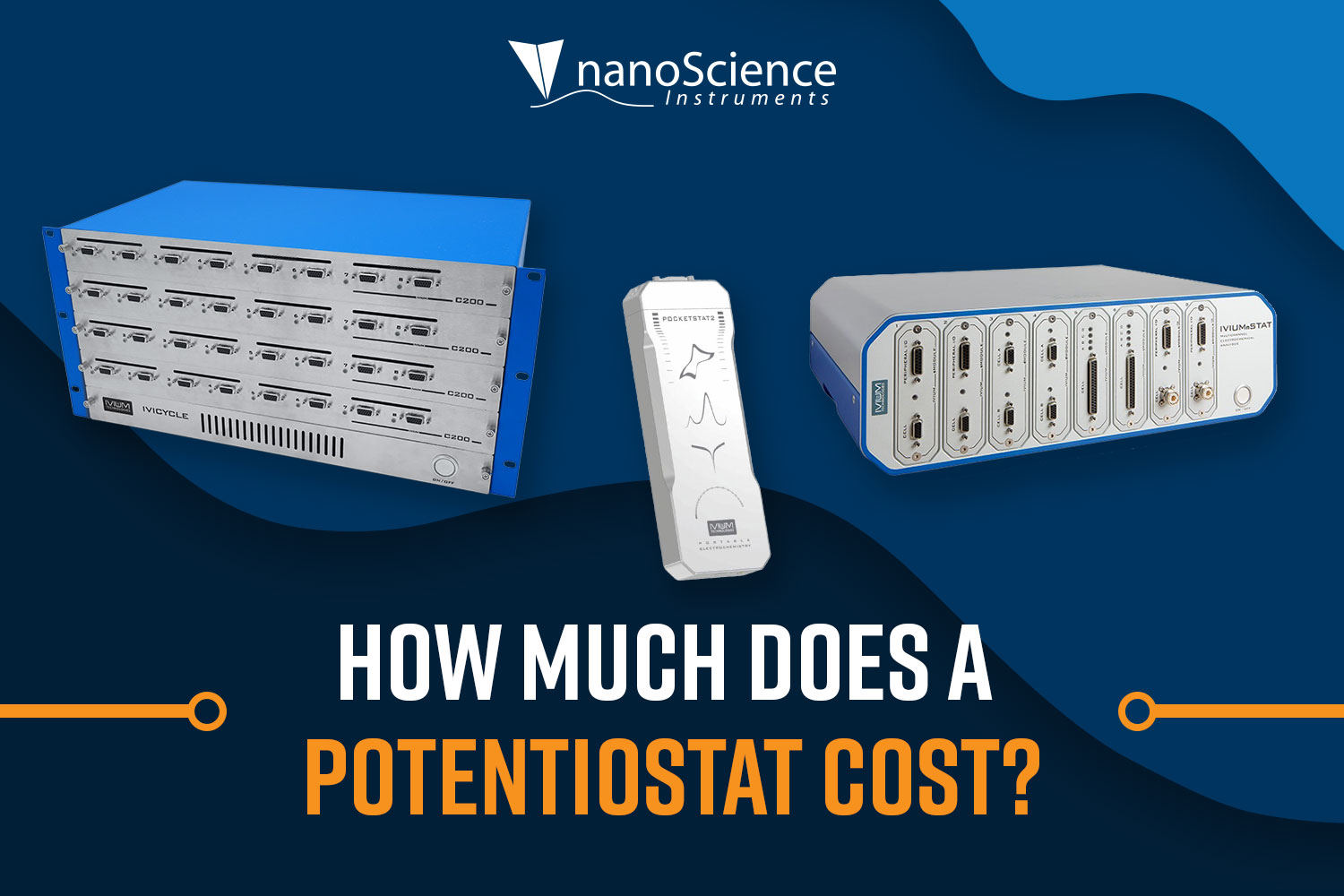Potentiostats are all-important tools in electrochemistry that offer precise control of the electrode’s potential and measurement of the current. These instruments play a critical part in electrochemical applications like corrosion testing, wearable electronics, battery research, analysis, and testing for many industries. Potentiostats range from simple handheld single-channel devices to high channel count battery cyclers, and entry-level low-powered systems to high-powered multi-channel instruments.
The cost of the potentiostat can vary significantly, based on the type and the capabilities of the system. The voltage rating, current capacity, number of channels, measurement modes, and additional accessories will all play a part in the price of the system. Higher power ratings and higher channel numbers result in higher costs. Other features that can affect cost include stability, accuracy, sensitivity, and performance of the system.

Portable Potentiostats:
Portable potentiostats are low-power systems making them perfect for corrosion and coatings measurements, analytical electrochemistry, and any other low-current electrochemical application. These portable potentiostats are generally the size and weight of a smartphone. They are usually powered and controlled via a USB connection to any Windows-operated computer. Some have the option of Bluetooth connectivity. Portable potentiostats are often used to perform electrochemistry tests in the field. The small footprint also makes them easy to use in the lab. Portable potentiostats usually cost under $10K.
Single-Channel Potentiostats:
Single-channel Potentiostats, as the name indicates, consists of one measurement channel. These are relatively compact units designed for use in a laboratory environment. Single-channel units can vary significantly with a variety of power configurations. The availability of a wide range of power configurations makes the single-channel potentiostats an ideal match for many applications, such as battery/fuel cell testing, sensors, electrode development, biotechnology, and routine electrochemical analysis. Single-channel units can range in price from just over $5K to around $30K. The price is dependent largely on the current and voltage rating of the unit.
Multi-Channel Potentiostats:
Multichannel instruments are designed for applications where multiple cells are operated in parallel for long periods. In addition to voltage and current rating, multi-channel units also vary significantly in price according to the number of channels available. The ability to mix and match low-power and high-power channels in a single system can also influence the price. The multichannel potentiostats generally have 8, 32, 64, or 128 channels, although systems with a larger number of channels are also available. The 8-channel potentiostats start under $40K with pricing increasing with the number of channels and capabilities needed per channel. In the case of multichannel potentiostats, it is best to consider the price per channel when trying to compare systems with different specifications.
Things to Consider Before Purchasing a Potentiostat:
The decision to purchase a potentiostat should not be made on price alone. Besides defining the voltage and current rating and the number of channels required, several other factors must also be considered including:
Impedance Capabilities
Impedance measurements are becoming an ever-increasing part of electrochemical measurements. An integrated impedance measurement module allows for the widest range of available experiments. Integration reduces the cable connection length that can degrade the applied voltages, allows for precise control of the potentiostat settings, and ensures that the highest quality measurement can be made. Measurement time is also reduced due to the on-demand availability. This is particularly important in battery testing protocols. Impedance frequency range also affects the price. For general electrochemistry and standard corrosion measurements, little information is available above 250 kHz, but for solid-state systems like solid oxide fuel cells higher frequencies may be needed up to 8 MHz. Higher impedance frequencies increase the cost of potentiostats.
Stability
Battery, fuel cell, and electrolysis experiments are long-term experiments and require stability in applied current and/or voltage signals. Instruments that incorporate multiple stability and filter settings provide the ability to control the measurements and eliminate extraneous noise. Stable measurement is an important factor for electrocatalysts, super-capacitors, and sensor experiments, as well.
Low Current Ranges
Low current measurements, in the nanoamp to picoamp region, are some of the most challenging measurements in electrochemistry. Potentiostats with true low current measurement ranges provide better low current measurements because they inherently filter out noise due to a better signal-to-noise ratio. This is important for microelectrode, sensor and paints and coatings measurements.
ADC Resolution
Analog current and voltage signals measured are converted to digital inputs using analog-to-digital converters (ADC). These divide the signal into individual discrete buckets or bits which gives the appearance of very small steps on the microscopic scale. The more bits you have, the closer your measurement is to the analog input. 16-bit converters are common, but higher-performance potentiostats and battery cyclers have 18- and 24-bit converters. The higher the resolution, the more accurate the measurement.
Data Security
A data backup option to ensure that the data is not lost in the event of an interruption such as a power outage or software crash during the data collection process is a necessity, especially when in long-term cycling experiments. This feature will prove to be an additional safety net when needed.
Software
Comprehensive software with unrestricted access to a full suite of electrochemical, corrosion, and battery tests is essential for a high-performance potentiostat or battery cycler system. It is common with several potentiostats that the software is limited to the interested measurement and any additional modes require additional licenses.
Modules and Accessories
The availability of additional modules and accessories such as boosters, multiplexers, communication modules, Faraday cage, and magnetic clamping cells are important criteria to consider. This would afford the user an upgrade path as the need grows. For example, a booster can extend the performance range of a potentiostat by extending the current or voltage range. Multiplexer modules extend the potentiostat functionality by allowing multiple measurements.
Warranty and Support
As with the purchase of any equipment it is critical to consider the warranty offering and available support. It is also critical to ensure that warranty repairs and support are available locally. The cost of support and any upgrades, including regular software upgrades, should also be considered.
Conclusion
The main contributing factors affecting the cost are the current and voltage ratings and the channel count. The performance, stability, sensitivity, and accuracy of the system also affect the price. As with any product, the lowest-cost potentiostat on the market may not offer the quality needed for accurate, repeatable experiments. It’s recommended to contact a technical expert from an authorized seller to get accurate and up-to-date pricing information for specific models that meet your requirements. They can provide detailed quotations and discuss additional costs that might affect the bottom line.








